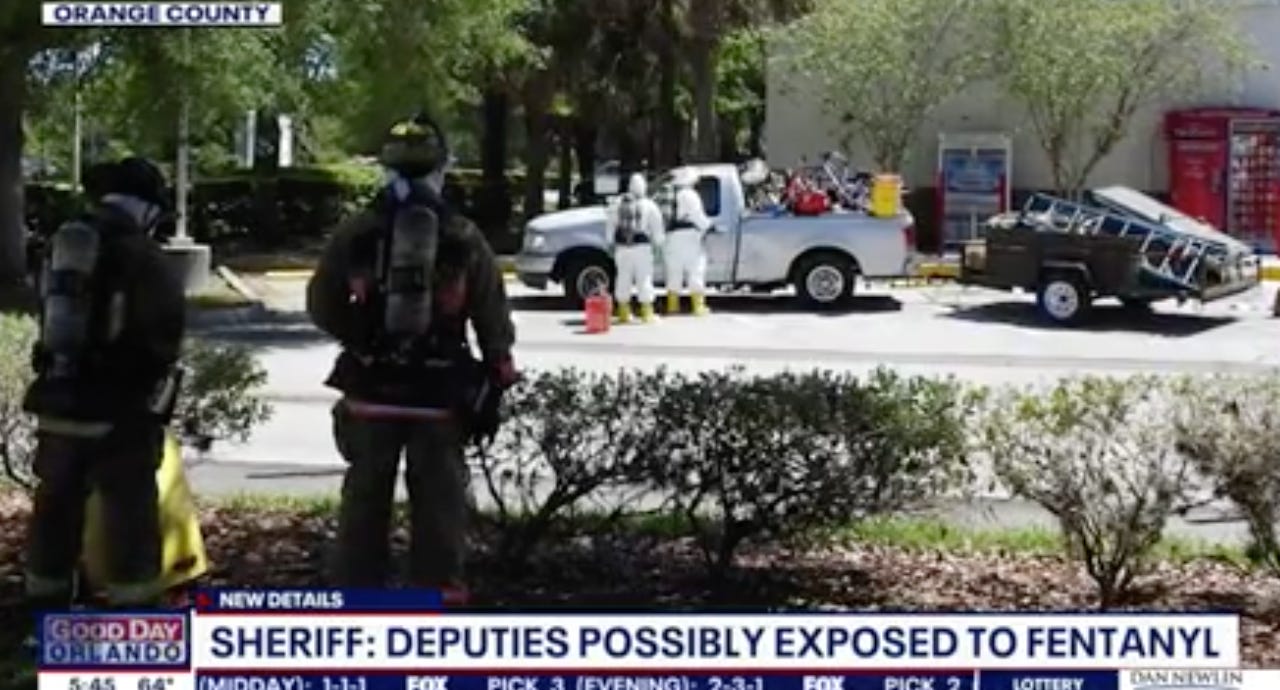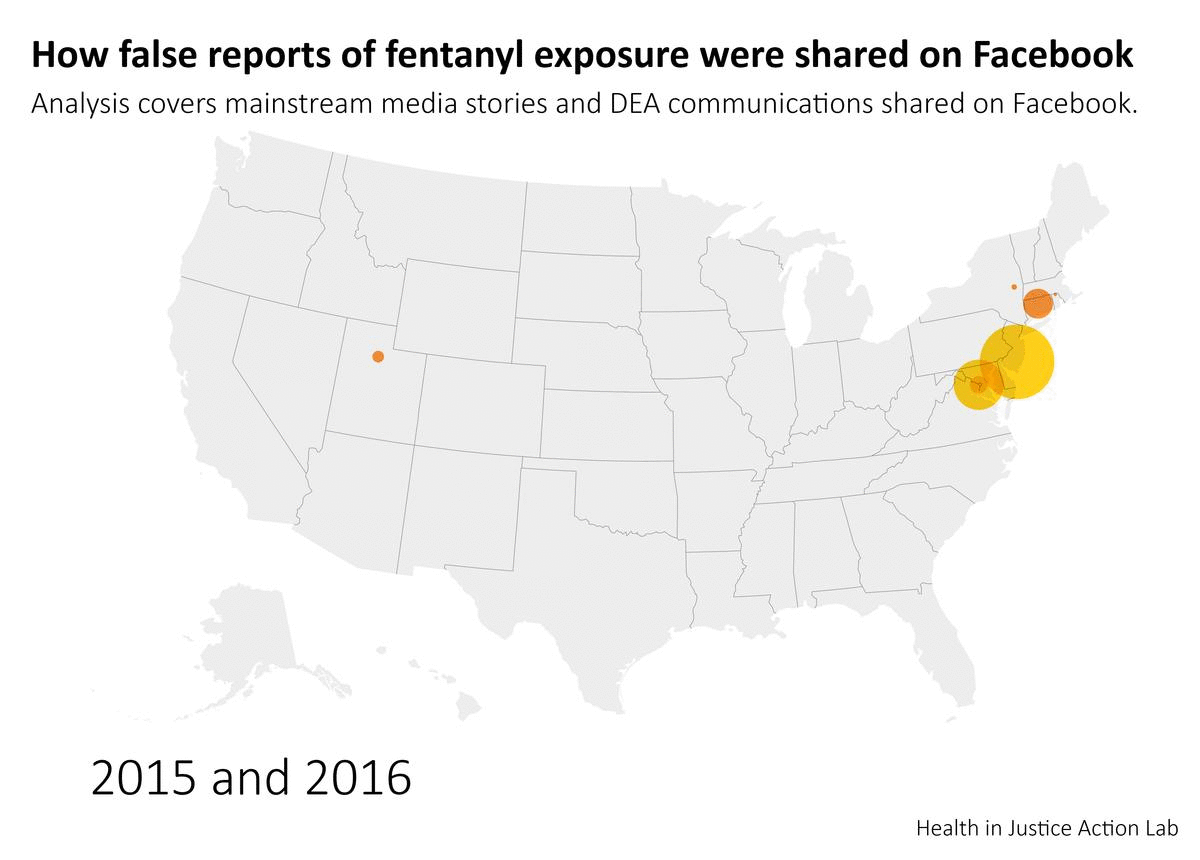Police Panic: Why Fentanyl Gives Cops "The Vapors"
Roll out the fainting couch. Local news outlets "copy and paste" police press releases, helping fuel an absurd social panic.
You know the drill. It’s Tuesday night in March, the 29th day, and you slip on your cozy Tommy John pajama pants, slide under the sheets, and start scrolling Twitter.
Your partner gives you the look, and sighs, “Haven’t you been scrolling enough today?” Yeah, pretty much, you have. But you shoot a look back and throw up your hands because this time, “THEY MADE ME DO IT!”
By they, I mean the local news. And what they did, again, for the umpteenth time, is copy and paste an absurd press release from their best friends, the local cops, about brave officers of the law claiming to have overdosed after standing seeing, or maybe standing near, the synthetic opioid fentanyl.
Maybe specks of fentanyl dust were in the air. How could one know?
Only this time, the deputies didn’t even “overdose,” per se. They felt kinda dizzy. Then they felt scared. Then their chest tightened. They felt short of breath. They remembered what their boss told them about fentanyl. That if you touch it you could die. They remember that DEA memo sent to every police department nationwide, explaining that fentanyl is like anthrax: Being near it could kill you. You could accidentally inhale a few grains. It’s so potent, so powerful, that even a teensy grain landing on your skin is enough to do you in.
After all, these cops have seen this happen to their colleagues around the country. That deputy in San Diego. That cop in Ohio (who eventually got fired for lying all the time). Those two detectives in New Jersey. So on the scene of routine harassment of the poor they sprayed naloxone up their nose, panicked, then called the Chernobyl Response Squad to hose them down and suit them up in protective gear. Remember that fentanyl could be suspended in the air, so they bust out the scuba oxygen tank to breathe outdoors, in a parking lot.
They even hosed down a dog.




Sitting in bed, the same night of March 29, and somehow the same thing happened in Ohio. Only this time it’s a prosecutor in a courtroom, who passed out during a trial after standing near a substance. The prosecutor was “exposed” to this substance. Somehow. The prosecutor had to be “revived” with Narcan.


Within minutes of all these Airborne Toxic Events, the press flacks cook up a statement to explain to the local news what transpired.
In Orange County, Florida, the deputies saw a suspicious truck parked on East Colonial Drive. It looked… out of place. Code for being poor in public. The people in the truck, harming no one, are just sitting there because maybe they have no where to go and nothing to really do. The deputies pull up and they see a trash strewn about, old fast food wrappers. They ask the two poor people to step out of the vehicle.
Scared, they cooperate, because what else are they gonna do.
The deputies find some tin foil, or a pill bottle, or a spoon, or maybe a syringe. Aha! Paraphernalia. Then the deputies find a plastic bag. Maybe some counterfeit pills. Perhaps some loose powder, a couple bumps worth. Now the poor people are criminals.
But the cops aren’t really worried about the criminals. They fear they might have accidentally come into contact with the toxic chemicals the bad criminals are using to get high.
"While searching the vehicle and the two occupants, deputies located suspected narcotics and other paraphernalia. During the search, three of the deputies became dizzy, and deployed Narcan on themselves as a precautionary measure," the sheriff's office said in a news release.
The flack’s statement neglects the fact that the two poor people sitting in the truck, ostensibly caked in fentanyl particles, seemed just fine. They showed no symptoms of anything being wrong with them.
The cops hosed them down and suited them up in hazmat anyway before handcuffing them. For everyone’s safety.
The harrowing scene is captured by Orange County, Florida’s local NBC-affiliate, WESH Channel 2, owned by the Hearst Corporation. (Hey I’ve freelanced for Hearst magazines! Think I got paid on time, can’t remember.) The segment’s producer dispatched the helicopter, named Chopper 2, for an aerial view of the sad scene where nothing, truly, is really happening.
The news said that the deputies went to the hospital but are believed to be OK. The now felons are being processed. Phew.
At no point did the local news think to check the flack’s statement. Is feeling dizzy even a symptom of a fentanyl overdose? No, it isn’t. If someone is overdosing, can they even Narcan themselves? Probably not. See, the key thing about an overdose is that the victim is unconscious. Does naloxone work like some sort of pre-exposure prophylactic? Putting up a shield that protects the opioid receptors inside the skulls of these deputies. I guess so, but that’s pretty silly.
None of these question matter, because they were never asked, and are never going to be asked. These questions also don’t matter because the Orlando, Florida, Fox-affiliate, FOX35, found a doctor wearing black scrubs (who scarily specializes in addiction medicine) for their news broadcast. The doctor said, wrongly, that microscopic amounts of fentanyl can be deadly to the touch, because fentanyl can absorbed through the skin. It can’t.
In fact, there’s tons of ways to get exposed to fentanyl, the doctor said:
“You never know when it’s in the air, or whether it’s dust in somebody’s car that’s potentially fentanyl.” If you touch fentanyl then rub your eye, maybe you’ll suffer from “ocular exposure.”
The only documented case of accidental fentanyl exposure in the research literature is in a clinical setting where a veterinarian accidentally squirted carfentanil in their eye while trying to sedate an elk. The vet felt drowsy, but thankfully there was an opioid antagonist on hand, blocking the effect. The vet survived. Don’t know about the elk.
Broadcast News
I get asked all the time why these news stories keep getting published.
It almost always starts with a local news broadcast. Patient Zero. Then, sometimes, national news outlets aggregate the local story, vastly expanding its reach. It goes viral. But the national outlets have now been so thoroughly humiliated and laughed at online that they seem to now know to stay away from these sensational stories about police feeling dizzy after seeing drugs at their job. San Diego news outlets got the worst of it last summer.
I know all this because I’ve studied this phenomenon at my part-time research and social media job at the Health in Justice Action Lab at Northeastern University’s Law School. We’ve published academic papers and analyzed thousands upon thousands of social media posts. One of these papers about fentanyl exposure is titled 🎵“Can Touch This.” All of our research on this is available for free at ChangingTheNarrative.com. It’s a website we created specifically for this problem, to help journalists who don’t know anything about drugs avoid these mistakes. We even have charts and graphs and animations. We even have a directory of experts who are willing to be quoted on the record. Please, use this free resource!
But the local news is shameless, or ignorant, or they just don’t give a shit. Every word of these latest Florida broadcasts and police statements has been debunked dozens of times over the past several years. But they’re breaking news. Which means they can’t be bothered to do due diligence. We also track corrections to these stories, which are rare and do not garner nearly as many views and shares as the original false story, whose visibility, we found, outmatches corrections and retractions by a factor of 15.
If the local news tried to Google anything about this they’d probably see this statement from the American College of Medical Toxicology. It says this phenomenon is scientifically not possible, because the properties and physics of fentanyl just don’t behave this way:
“Even if a large area of the body were covered with fentanyl patches, it would take 14 minutes to transmit a therapeutic dose of 100 micrograms, let alone an overdose,” the scientists say.
Or maybe they’d see an editorial from the New York Times saying the same thing. Or maybe they’d see a statement from doctors like Ryan Marino pop up. In fact, on Sunday night, March 27th, Marino was quoted on John Oliver’s HBO show, saying: “You would have to be in some sort of wind tunnel with massive amounts of fentanyl” in order to overdose on it by accident. Do cops watch HBO?
So what have we learned from this latest round of absurd, impossible falsehoods?
Doing reporting and research for so many years on this topic, I’ve learned that the simplest answers are usually the closest to the truth: Local news teams will keep running whatever stories the local police serve up to them.
But the political and social context of drugs in America is a bit more complex. An existing context must exist in order for a story like this to be believed in the first place. The fear, the panic, can really only be understood through understanding the racist and dehumanizing history of drug policing. These fentanyl exposure stories are really stories are about dehumanization, about courageous heroes and dangerous villains.
The police are convinced that the work they’re doing is incredibly dangerous. Sometimes it is, but rarely for the reasons they think. They think hosing down and arresting drug users is somehow helping. You see, it’s not drug users who are at risk from the contaminated drug supply, even though more than 100,000 people are dying every year from overdoses. It’s the police who are really at risk, and they’re at risk because they’re trying to save drug users from themselves, they’re at risk because they’re trying to rid their community of bad chemicals and bad people.
The police cannot put out a statement saying that the deputies got scared, started to panic, and Narcan’d themselves. It’s just not going to happen. So, like all police statements, they are retroactive in nature, and their whole point is to find an excuse or rationale to justify whatever way the police behaved in a given moment.
Police don’t feel fear, they see threats. And whatever they do—whether it’s shooting an unarmed person or spraying naloxone up their nose—it’s because their own safety was threatened. And when cops feel threatened, the news is there to report it, reinforcing the dangerousness of the job while broadcasting to the community that two people sitting in their truck doing nothing are now felons who have been taken off the streets.
There is no simple way to stop these stories from being broadcasted because these broadcasts serve a necessary function.
So, disempowered as well are, as we all feel, the most we can do is yell about it on Twitter. The good news: Lately, our yelling has gotten more organized. More targeted. Experts like Lucas Hill, a humble pharmacist in Texas, organized a massive retraction request letter that can be deployed in an instant. I encourage you to use this too.
And I’ll be in my pajamas each night explaining the basics of how human skin works, how the genius of skin is that it prevents random stuff in the world from entering our bloodstream. So I’ll be up at night explaining how skin works while my beautiful and caring partner is having much more fun reading comic books and science fiction next to me in our comfortable bed.
She’ll pat me on the back for trying, again.










❤️
just so beautifully worded